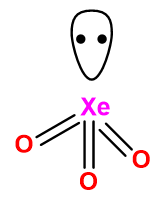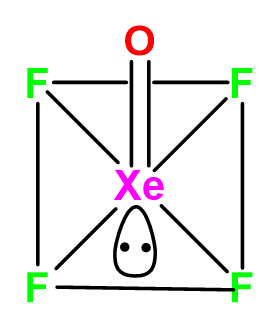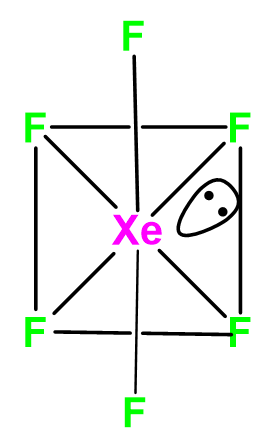
Among the following molecules (i) \[Xe{O_3}\](ii) \[XeO{F_4}\](iii) \[Xe{F_6}\] . Those having the same number of lone pairs on \[Xe\] are.
(a) (i) and (ii) only
(b) (i) and (iii) only
(c) (ii) and (iii) only
(d) (i), (ii) and (iii)
Answer
224.7k+ views
Hint: Xenon is a member of the noble gas family, and it has\[n{s^2}n{p^6}\]outer shell electronic configuration. Xenon can directly react with fluorine and oxygen and can form a variety of compounds such as., \[Xe{F_2}\], \[Xe{F_4}\], \[Xe{F_6}\], \[Xe{O_3}\] and \[XeO{F_2}\].
Complete Step by Step Solution:
In the given question we have to find out the compounds that have the same number of lone pairs of electrons. By using VSEPR theory we can easily find out the number of lone pairs of electrons in the given compounds of xenon.
The structure of \[Xe{O_3}\](xenon trioxide) has the \[Xe\] as a central atom and it is surrounded by three oxygen atoms via \[Xe = O\] bonds (covalent bonds). The exact structure of \[Xe{O_3}\]is represented below which represents the presence of one lone pair of electrons on the xenon centre.

Image: Structure of \[Xe{O_3}\].
Similarly, the structure of \[XeO{F_4}\] contain \[Xe\] as the central atom and it is surrounded by one oxygen and four fluorine atoms via \[Xe = O\] and \[Xe - F\] bond respectively. Like the structure of \[Xe{O_3}\], \[XeO{F_4}\] also has one lone pair of electrons on a xenon atom. The \[XeO{F_4}\]has a square pyramidal shape and \[s{p^3}{d^2}\]hybridization.

Image: Structure of \[XeO{F_4}\].
Similarly, the structure of \[XeO{F_4}\]contain \[Xe\]as the central atom and it is surrounded by one oxygen and four fluorine atoms via \[Xe = O\] and \[Xe - F\] bond respectively. Like the structure of \[Xe{O_3}\], \[XeO{F_4}\]also has one lone pair of electrons on a xenon atom. The \[XeO{F_4}\]has square pyramidal shape and \[s{p^3}{d^2}\]hybridization for \[Xe\] atoms.
Whereas the structure of \[Xe{F_6}\]has a different structure than the \[Xe{O_3}\]and \[XeO{F_4}\]. The \[Xe{F_6}\]molecule possesses six fluorine atoms which are bonded with the \[Xe\]atom. The central \[Xe\]atom has \[s{p^3}{d^3}\]hybridization and distorted octahedral or capped octahedral shape due to the presence of one lone pair of electrons on \[Xe\] centre.

Image: Structure of \[Xe{F_6}\].
Therefore from the above explanation we can also observe that the \[Xe{O_3}\]\[XeO{F_4}\]and \[Xe{F_6}\] have only one lone pair of electrons on xenon atom. Hence option (d) will be the correct option.
Note: The VSEPR theory also explains the lone pair and bond pair repulsion in the molecules. The VSEPR theory also explains the lone pair -lone pair repulsion is larger compared to the lone pair -bond pair and bond pair-bond pair repulsion. Therefore, lone pair-lone pair repulsion> lone pair -bond pair repulsion > bond pair -bond pair repulsion.
Complete Step by Step Solution:
In the given question we have to find out the compounds that have the same number of lone pairs of electrons. By using VSEPR theory we can easily find out the number of lone pairs of electrons in the given compounds of xenon.
The structure of \[Xe{O_3}\](xenon trioxide) has the \[Xe\] as a central atom and it is surrounded by three oxygen atoms via \[Xe = O\] bonds (covalent bonds). The exact structure of \[Xe{O_3}\]is represented below which represents the presence of one lone pair of electrons on the xenon centre.

Image: Structure of \[Xe{O_3}\].
Similarly, the structure of \[XeO{F_4}\] contain \[Xe\] as the central atom and it is surrounded by one oxygen and four fluorine atoms via \[Xe = O\] and \[Xe - F\] bond respectively. Like the structure of \[Xe{O_3}\], \[XeO{F_4}\] also has one lone pair of electrons on a xenon atom. The \[XeO{F_4}\]has a square pyramidal shape and \[s{p^3}{d^2}\]hybridization.

Image: Structure of \[XeO{F_4}\].
Similarly, the structure of \[XeO{F_4}\]contain \[Xe\]as the central atom and it is surrounded by one oxygen and four fluorine atoms via \[Xe = O\] and \[Xe - F\] bond respectively. Like the structure of \[Xe{O_3}\], \[XeO{F_4}\]also has one lone pair of electrons on a xenon atom. The \[XeO{F_4}\]has square pyramidal shape and \[s{p^3}{d^2}\]hybridization for \[Xe\] atoms.
Whereas the structure of \[Xe{F_6}\]has a different structure than the \[Xe{O_3}\]and \[XeO{F_4}\]. The \[Xe{F_6}\]molecule possesses six fluorine atoms which are bonded with the \[Xe\]atom. The central \[Xe\]atom has \[s{p^3}{d^3}\]hybridization and distorted octahedral or capped octahedral shape due to the presence of one lone pair of electrons on \[Xe\] centre.

Image: Structure of \[Xe{F_6}\].
Therefore from the above explanation we can also observe that the \[Xe{O_3}\]\[XeO{F_4}\]and \[Xe{F_6}\] have only one lone pair of electrons on xenon atom. Hence option (d) will be the correct option.
Note: The VSEPR theory also explains the lone pair and bond pair repulsion in the molecules. The VSEPR theory also explains the lone pair -lone pair repulsion is larger compared to the lone pair -bond pair and bond pair-bond pair repulsion. Therefore, lone pair-lone pair repulsion> lone pair -bond pair repulsion > bond pair -bond pair repulsion.
Recently Updated Pages
JEE Main 2025-26 Mock Test: Organic Compounds Containing Nitrogen

JEE Main 2025-26 Organic Compounds Containing Nitrogen Mock Test

JEE Main Chemical Kinetics Mock Test 2025-26: Free Practice Online

JEE Main 2025-26 Organic Compounds Containing Oxygen Mock Test

JEE Main 2025-26 Organic Compounds Containing Halogens Mock Test

Sodium acetate on heating with soda lime produce A class 12 chemistry JEE_Main

Trending doubts
JEE Main 2026: City Intimation Slip and Exam Dates Released, Application Form Closed, Syllabus & Eligibility

JEE Main 2026 Application Login: Direct Link, Registration, Form Fill, and Steps

Understanding the Angle of Deviation in a Prism

How to Convert a Galvanometer into an Ammeter or Voltmeter

Hybridisation in Chemistry – Concept, Types & Applications

Ideal and Non-Ideal Solutions Explained for Class 12 Chemistry

Other Pages
NCERT Solutions For Class 12 Chemistry Chapter 1 Solutions - 2025-26

JEE Advanced Marks vs Ranks 2025: Understanding Category-wise Qualifying Marks and Previous Year Cut-offs

Solutions Class 12 Chemistry Chapter 1 CBSE Notes - 2025-26

NCERT Solutions ForClass 12 Chemistry Chapter Chapter 4 The D and F Block Elements

Biomolecules Class 12 Chemistry Chapter 10 CBSE Notes - 2025-26

NCERT Solutions For Class 12 Chemistry Chapter 10 Biomolecules - 2025-26




